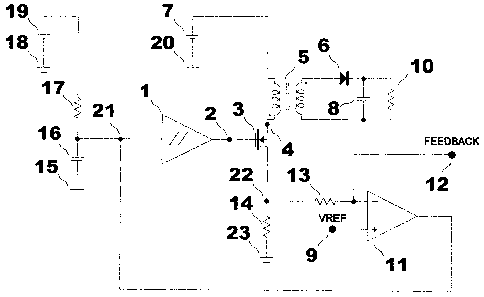Some of the information on this Web page has been provided by external sources. The Government of Canada is not responsible for the accuracy, reliability or currency of the information supplied by external sources. Users wishing to rely upon this information should consult directly with the source of the information. Content provided by external sources is not subject to official languages, privacy and accessibility requirements.
Any discrepancies in the text and image of the Claims and Abstract are due to differing posting times. Text of the Claims and Abstract are posted:
| (12) Patent Application: | (11) CA 2567462 |
|---|---|
| (54) English Title: | SPIKE CONVERTER |
| (54) French Title: | CONVERTISSEUR DE POINTE |
| Status: | Deemed Abandoned and Beyond the Period of Reinstatement - Pending Response to Notice of Disregarded Communication |
| (51) International Patent Classification (IPC): |
|
|---|---|
| (72) Inventors : |
|
| (73) Owners : |
|
| (71) Applicants : |
|
| (74) Agent: | |
| (74) Associate agent: | |
| (45) Issued: | |
| (22) Filed Date: | 2006-11-08 |
| (41) Open to Public Inspection: | 2008-05-08 |
| Availability of licence: | N/A |
| Dedicated to the Public: | N/A |
| (25) Language of filing: | English |
| Patent Cooperation Treaty (PCT): | No |
|---|
| (30) Application Priority Data: | None |
|---|
The present invention is a spike converter providing a special mode of
operation of a low power fly-back
converter in a very narrow duty cycle range in particular. This spike
operation minimizes the size of the
required reactive components such as that of the power transformer and output
capacitance. The present
invention automatically achieves low idle power consumption due to the nature
of the feedback under
fixed, narrow duty cycle or spike operation. The spike operation is defined by
the lower limit of the on time
of the switching element being generated by the sum of the propagation delays
of a current sense
comparator and an off time pulse generating comparator.
Note: Claims are shown in the official language in which they were submitted.
Note: Descriptions are shown in the official language in which they were submitted.

2024-08-01:As part of the Next Generation Patents (NGP) transition, the Canadian Patents Database (CPD) now contains a more detailed Event History, which replicates the Event Log of our new back-office solution.
Please note that "Inactive:" events refers to events no longer in use in our new back-office solution.
For a clearer understanding of the status of the application/patent presented on this page, the site Disclaimer , as well as the definitions for Patent , Event History , Maintenance Fee and Payment History should be consulted.
| Description | Date |
|---|---|
| Time Limit for Reversal Expired | 2012-11-08 |
| Application Not Reinstated by Deadline | 2012-11-08 |
| Inactive: Adhoc Request Documented | 2012-08-10 |
| Inactive: Abandon-RFE+Late fee unpaid-Correspondence sent | 2011-11-08 |
| Deemed Abandoned - Failure to Respond to Maintenance Fee Notice | 2011-11-08 |
| Change of Address or Method of Correspondence Request Received | 2009-02-06 |
| Application Published (Open to Public Inspection) | 2008-05-08 |
| Inactive: Cover page published | 2008-05-07 |
| Inactive: IPC assigned | 2007-02-14 |
| Inactive: First IPC assigned | 2007-02-14 |
| Inactive: IPC assigned | 2007-02-14 |
| Filing Requirements Determined Compliant | 2006-12-19 |
| Inactive: Filing certificate - No RFE (English) | 2006-12-19 |
| Application Received - Regular National | 2006-12-12 |
| Small Entity Declaration Determined Compliant | 2006-11-08 |
| Abandonment Date | Reason | Reinstatement Date |
|---|---|---|
| 2011-11-08 |
The last payment was received on 2010-11-08
Note : If the full payment has not been received on or before the date indicated, a further fee may be required which may be one of the following
Please refer to the CIPO Patent Fees web page to see all current fee amounts.
| Fee Type | Anniversary Year | Due Date | Paid Date |
|---|---|---|---|
| Application fee - small | 2006-11-08 | ||
| MF (application, 2nd anniv.) - small | 02 | 2008-11-10 | 2008-09-29 |
| MF (application, 3rd anniv.) - small | 03 | 2009-11-09 | 2009-10-07 |
| MF (application, 4th anniv.) - small | 04 | 2010-11-08 | 2010-11-08 |
Note: Records showing the ownership history in alphabetical order.
| Current Owners on Record |
|---|
| IVAN MESZLENYI |
| Past Owners on Record |
|---|
| None |